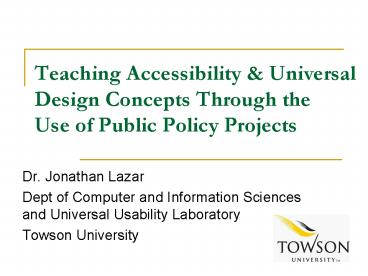Teaching Accessibility - PowerPoint PPT Presentation
1 / 16
Title:
Teaching Accessibility
Description:
Teaching Accessibility & Universal Design Concepts Through the Use of Public Policy Projects Dr. Jonathan Lazar Dept of Computer and Information Sciences and ... – PowerPoint PPT presentation
Number of Views:107
Avg rating:3.0/5.0
Title: Teaching Accessibility
1
Teaching Accessibility Universal Design
Concepts Through theUse of Public Policy
Projects
- Dr. Jonathan Lazar
- Dept of Computer and Information Sciences and
Universal Usability Laboratory - Towson University
2
- How do you structure a research paper assignment
in a way that it - Is interesting to the students?
- Is unlikely to simply be copied from the
Internet? - Will actually help students understand concepts
in a hands-on way? - Will perform something useful for society?
3
And also deal with the fact that
- Much of the policymaking that occurs in the area
of IT accessibility, is done using LITTLE TO NO
EMPIRICAL DATA!!! - Policymakers are starving for data to understand
whats going on!
4
Old Research Paper Assignments
Comic from http//www.anthonyarroyodotcom.com
- Human-Computer Interaction undergraduate class
- All Information Systems and Information
Technology majors - Students chose their own topic within HCI
- 10-12 page paper
- With citations and references
5
New approach to research papers
- Class-wide public policy projects
- Students learn
- 1. international guidelines related to web
accessibility - 2. how to evaluate web sites for accessibility
- 3. specific details of federal and state laws
related to web accessibility - The students then perform a series of
accessibility inspections on a group of web sites
that are required under law to be accessible
6
Why this approach is better
- Students appreciate the hands-on nature of the
evaluations - Students are more engaged, since its useful
writing for an external audience - Students experience the relationship between law
and human-computer interaction - Students see that their work can have a real
impact
7
How the Intro to HCI class is structured
- Junior/Senior undergraduate level course
- Nearly all students come in with basic web
programming skills - Most students come in with no understanding of UD
or HCI, and no background in the area of
disability or accessibility - I introduce the topics of web accessibility and
public policy - I ask students to utilize a screenreader
(download when necessary)
8
Students Learn
- Web Accessibility
- Screen readers, captioning, and other types of
assistive technologies - WCAG 2.0
- Public Policy
- Section 508
- Maryland IT Non-Visual Access Regulations
- Americans with Disabilities Act
- Students learn 1) who is legally required to be
accessible and 2) what that means to be accessible
9
Practice, practice, practice
- Students cant just do an accessibility
inspection for the first time and become
confident and knowledgeable - You need to do a LOT of exercises first!
- Start with the university home page, then
departmental web pages, then local organizations
that students are familiar with - Encourage questioning and admitting confusion
10
Method for the accessibility evaluations
- Use a screen reader, along with a written set of
instructions on accessibility inspections - 1. Listen to the web page being read out loud,
while looking at the page - 2. Use three common navigation methods
- Headers
- Links lists
- Keyword searching
- 3. Check the web page code for compliance with
each one of the legal paragraphs - The evaluation covers more than just blind users
11
Categories of potential study
- State or local government web sites
- University web sites
- Including course materials, videos, and lifecycle
systems (applying to college, registering for
classes, and applying for graduation) - Local stores which would fall under legal
requirements - Public transportation (busses, subway, etc.)
- Public libraries
12
Method for the evaluations
- Each web page gets 5 individual inspections from
students - Group meeting is held, where professor leads a
discussion of the differences in each of the 5
inspections - One student is the lead evaluator for that web
page, and integrates the discussion into a
meta-evaluation, summarizing all 5 reviews - Be clear, that each individual evaluation wont
be perfect - Also helps teach about why we do multiple
reviewers
13
Outcomes
- The class summarizes the data in a series of
online spreadsheets - The professor takes the leadership role on
writing up the report (students comment on it) - Final report is sent to appropriate local, state,
or federal government officials - Final report is also submitted for potential
publication in a conference or journal, with all
students as co-authors
14
What happens if it doesnt work?
- If students dont follow through or take the
evaluations seriously - No report is written
- No data is sent outside of the class
- But students still get hands-on experience doing
accessibility inspections - So you cant PROMISE a report to any outside
entities before the semester is over with
15
Previous Examples
- Job placement and travel web sites (Spring 2010)
- E-commerce web sites where there are web-only
prices and also physical stores (Fall 2010) - Maryland Public Library web sites (Spring 2011)
- Airline web sites (Fall 2009 and Fall 2011)
- Maryland state government web sites (Spring 2012)
16
Suggestions for educators
- Undergraduate students are not immediately
experts in something that they just learned, they
need practice! - There need to be pedagogical-related goals for
these projects! - The professor needs to check, and check, and
re-check the data! - Be aware of any potential politics































